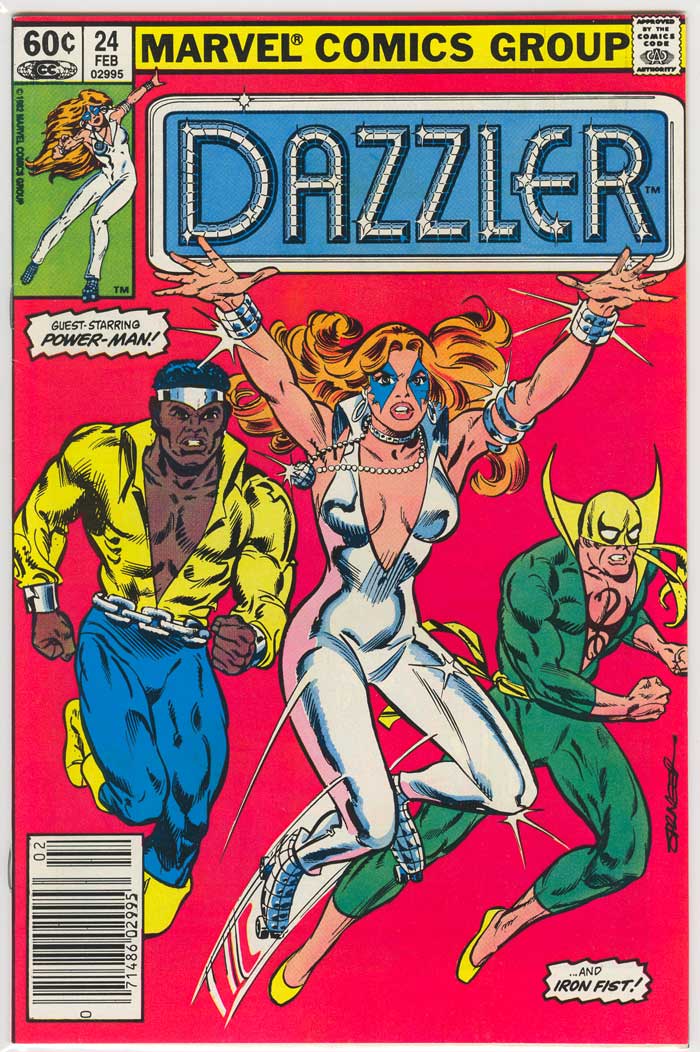 Dazzler (Alison Blaire) is a Marvel Comics superhero, associated with the X-Men. She first appeared in Uncanny X-Men #130 (February 1980).
Dazzler (Alison Blaire) is a Marvel Comics superhero, associated with the X-Men. She first appeared in Uncanny X-Men #130 (February 1980).A mutant with the ability to convert sound vibrations into light and energy beams, Dazzler was originally developed as a cross-promotional, multi-media creation between Casablanca Records, Filmworks, and Marvel Comics until the tie-ins were dropped in 1980. The character was created by a committee of Marvel staff, principally writer/editor Tom DeFalco and illustrator John Romita, Jr.
Despite the fact that Dazzler was originally commissioned as a disco singer, the character shifted to other musical genres, including rock and adult contemporary. She starred in a self-titled solo series in the early 1980s which lasted 42 issues, a Marvel Graphic Novel titled Dazzler: The Movie, a 4 issue limited-series co-starring Hank "The Beast" McCoy titled Beauty and The Beast, and later joined the cast of the X-Men. She was briefly a member of the spin-off group Excalibur but now has re-joined the X-Men.
 A dazzler is a type of a directed-energy weapon employing intense visible light, usually generated by a laser (laser dazzler). It is a non-lethal weapon intended to cause temporary blindness or disorientation. The first reported use of laser dazzlers in combat was by the British, during the Falklands War of 1982, when they were fitted to various Royal Navy warships in order to hinder low-level Argentinian air attacks.[1][2] Blinding weapons are banned by 1995 United Nations Protocol on Blinding Laser Weapons. Dazzlers are not intended to cause permanent blindness, therefore are thought to be able to skirt this regulation.
A dazzler is a type of a directed-energy weapon employing intense visible light, usually generated by a laser (laser dazzler). It is a non-lethal weapon intended to cause temporary blindness or disorientation. The first reported use of laser dazzlers in combat was by the British, during the Falklands War of 1982, when they were fitted to various Royal Navy warships in order to hinder low-level Argentinian air attacks.[1][2] Blinding weapons are banned by 1995 United Nations Protocol on Blinding Laser Weapons. Dazzlers are not intended to cause permanent blindness, therefore are thought to be able to skirt this regulation.Narrowband optical filters tuned to the frequency of the laser used may provide a good defense against laser dazzlers. On the other hand, the dazzlers may employ lasers using more than one wavelength, or tunable lasers with wider range of output. Photochromic materials capable of becoming opaque under high light energy densities may provide protection as well. Non-linear optics techniques are being investigated as well; eg. vanadium-doped zinc telluride (ZnTe:V) can be used to construct electro-optic power limiters capable of selectively blocking the intense dazzler beam without affecting the weaker light from the observed scene.
 Optionally they can operate in infrared when their targets are electronic sensors. Most of the contemporary systems are man-portable, and operate in either red (a semiconductor laser) or green (a DPSS laser) part of the spectrum.
Optionally they can operate in infrared when their targets are electronic sensors. Most of the contemporary systems are man-portable, and operate in either red (a semiconductor laser) or green (a DPSS laser) part of the spectrum.Some searchlights are bright enough to cause permanent or temporary blindness and have been used to dazzle the crews of bombers during World War II. Handgun mounted lights may also be used to temporarily blind an opponent and are sometimes marketed for that purpose. In both cases the primary purpose is to illuminate the target and their use to disorient is secondary.
No comments:
Post a Comment